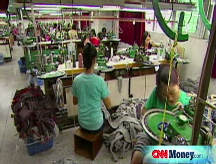Shoppers: Wait 'til next year
Experts say sharp slowdown in China's manufacturing sector bodes well for retailers and consumers in 2009.
NEW YORK (CNNMoney.com) -- While U.S. merchants are a few weeks away from wrapping up a potentially disastrous 2008, experts say there is some relief on the horizon in 2009 for both stores and consumers - and it's coming from thousands of miles away in China.
As consumer demand slows and retailers cut back their orders from China, "the bargaining power [over prices] is clearly back with retailers," said Craig Johnson, president of retail consulting group Customer Growth Partners.
For American shoppers and sellers, that could actually be a little bit of positive news in an otherwise dismal retailing environment, Johnson said.
'It's a positive for consumers because it will enable retailers to maintain lower prices in 2009 in hopes of spurring demand," he said.
This is also important for the broader economy since consumer spending fuels two-thirds of the nation's economic activity.
And Johnson said the upside for merchants is that if retailers keep tight control over inventory and rein in other business costs, they could still be able to maintain "decent levels of profitability" in a soft economy.
The United States is among China's biggest customers for a number of products. The U.S. accounted for 15% of total Chinese clothing exports in the first eight months of 2008, according to Bain & Co.'s China analyst Richard Ho.
America's share of Chinese toys and footwear imports was even larger, at 30% for toys and 35% for footwear, Ho said.
But China's manufacturing sector - which produced a sizeable 14% of these consumer goods imported into the United States last year - has decelerated rapidly over the past few months.
Retail analysts cite two main reasons for this contraction.
First, the global economic and subsequent consumer spending slowdown, has stymied demand for discretionary goods, many of which are made in China.
Second, Chinese manufacturers are battling rising labor and material costs at the same time that a rising Yuan versus the dollar is making Chinese exports to the U.S. and elsewhere more expensive.
Because of these challenges, more than 65,000 Chinese factories have gone bankrupt this year, said Lan Hailin, professor of business strategy with the South China University of Technology in Guangzhou, China.
And as overseas orders continue to shrink, Hailin thinks the number of bankruptcies will keep rising.
Michael Englund, chief economist with Action Economics, also sees this as a potential positive for American consumers, but with one caveat.
"The real key to this scenario working in favor of U.S. retailers is that the person who gets laid off is not the American worker but the worker in China," Englund said.
"The opposite would be a big problem," he said. That's because even if retailers can keep store prices low, people still won't buy more products if they're worried about losing their jobs.
However, some retail analysts argue that a shrinking supplier base in China could be problematic for U.S. merchants.
Marshall Meyer, professor of management at University of Pennsylvania's Wharton School, said vendor prices in China could in fact increase.
"We have relied for many years on lower prices in China. That's coming to an end," he said, adding that a decreasing supplier base would actually give the remaining vendors greater power to negotiate higher prices with their customers.
For its part, the National Retail Federation (NRF) maintains that the drop in orders for consumer goods in China is having a detrimental impact on suppliers there.
"It's a demand-supply issue," said Eric Autor, international trade counsel with the NRF.
"But even before the financial crisis hit, we saw retailers placing fewer orders in China as production costs started to rise," he said, adding that many retailers are shifting more production to Latin America and elsewhere in Asia.
In this situation, Autor said Chinese manufacturers "will probably be receptive to bargaining on prices because they are scrambling for whatever business they can get." ![]()



